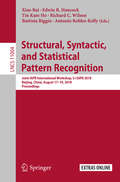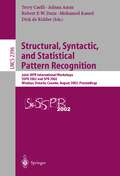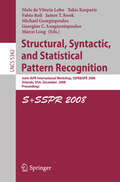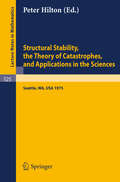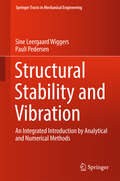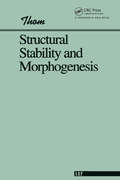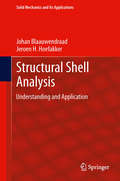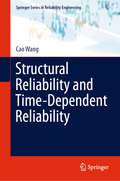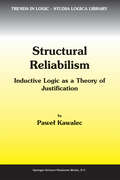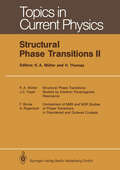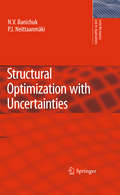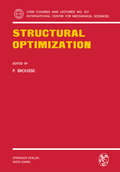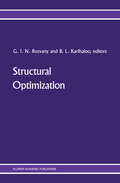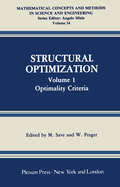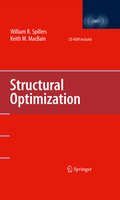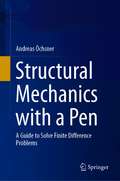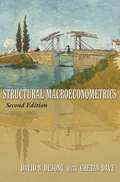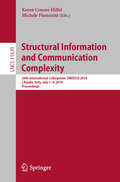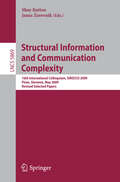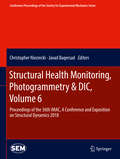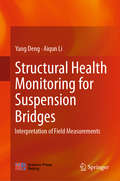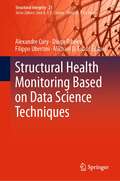- Table View
- List View
Structural, Syntactic, and Statistical Pattern Recognition: Joint IAPR International Workshop, S+SSPR 2018, Beijing, China, August 17–19, 2018, Proceedings (Lecture Notes in Computer Science #11004)
by Xiao Bai Edwin R. Hancock Tin Kam Ho Richard C. Wilson Battista Biggio Antonio Robles-KellyThis book constitutes the proceedings of the Joint IAPR International Workshop on Structural, Syntactic, and Statistical Pattern Recognition, S+SSPR 2018, held in Beijing, China, in August 2018.The 49 papers presented in this volume were carefully reviewed and selected from 75 submissions. They were organized in topical sections named: classification and clustering; deep learning and neurla networks; dissimilarity representations and Gaussian processes; semi and fully supervised learning methods; spatio-temporal pattern recognition and shape analysis; structural matching; multimedia analysis and understanding; and graph-theoretic methods.
Structural, Syntactic, and Statistical Pattern Recognition: Joint IAPR International Workshops SSPR 2002 and SPR 2002, Windsor, Ontario, Canada, August 6-9, 2002. Proceedings (Lecture Notes in Computer Science #2396)
by Terry Caelli Adnan Amin Robert P. W. Duin Mohamed Kamel Dick De RidderThis volume contains all papers presented at SSPR 2002 and SPR 2002 hosted by the University of Windsor, Windsor, Ontario, Canada, August 6-9, 2002. This was the third time these two workshops were held back-to-back. SSPR was the ninth International Workshop on Structural and Syntactic Pattern Recognition and the SPR was the fourth International Workshop on Statis- cal Techniques in Pattern Recognition. These workshops have traditionally been held in conjunction with ICPR (International Conference on Pattern Recog- tion), and are the major events for technical committees TC2 and TC1, resp- tively, of the International Association of Pattern Recognition (IAPR). The workshops were held in parallel and closely coordinated. This was an attempt to resolve the dilemma of how to deal, in the light of the progressive specialization of pattern recognition, with the need for narrow-focus workshops without further fragmenting the ?eld and introducing yet another conference that would compete for the time and resources of potential participants. A total of 116 papers were received from many countries with the submission and reviewingprocesses beingcarried out separately for each workshop. A total of 45 papers were accepted for oral presentation and 35 for posters. In addition four invited speakers presented informative talks and overviews of their research. They were: Tom Dietterich, Oregon State University, USA Sven Dickinson, the University of Toronto, Canada Edwin Hancock, University of York, UK Anil Jain, Michigan State University, USA SSPR 2002 and SPR 2002 were sponsored by the IAPR and the University of Windsor.
Structural, Syntactic, and Statistical Pattern Recognition: Joint IAPR International Workshop, SSPR & SPR 2008, Orlando, USA, December 4-6, 2008. Proceedings (Lecture Notes in Computer Science #5342)
by Niels Da Vitoria Lobo Takis Kasparis Michael Georgiopoulos Fabio Roli James Kwok Georgios C. Anagnostopoulos Marco LoogThis volume in the Springer Lecture Notes in Computer Science (LNCS) series contains 98 papers presented at the S+SSPR 2008 workshops. S+SSPR 2008 was the sixth time that the SPR and SSPR workshops organized by Technical Committees, TC1 and TC2, of the International Association for Pattern Rec- nition (IAPR) wereheld as joint workshops. S+SSPR 2008was held in Orlando, Florida, the family entertainment capital of the world, on the beautiful campus of the University of Central Florida, one of the up and coming metropolitan universities in the USA. S+SSPR 2008 was held during December 4–6, 2008 only a few days before the 19th International Conference on Pattern Recog- tion(ICPR2008),whichwasheldin Tampa,onlytwo hoursawayfromOrlando, thus giving the opportunity of both conferences to attendees to enjoy the many attractions o?ered by two neighboring cities in the state of Florida. SPR 2008 and SSPR 2008 received a total of 175 paper submissions from many di?erent countries around the world, thus giving the workshop an int- national clout, as was the case for past workshops. This volume contains 98 accepted papers: 56 for oral presentations and 42 for poster presentations. In addition to parallel oral sessions for SPR and SSPR, there was also one joint oral session with papers of interest to both the SPR and SSPR communities. A recent trend that has emerged in the pattern recognition and machine lea- ing research communities is the study of graph-based methods that integrate statistical andstructural approaches.
Structural Stability, the Theory of Catastrophes, and Applications in the Sciences: Proceedings of the Conference held at Battelle Seattle Research Center 1975 (Lecture Notes in Mathematics #525)
by P. HiltonStructural Stability and Vibration: An Integrated Introduction by Analytical and Numerical Methods (Springer Tracts in Mechanical Engineering)
by Sine Leergaard Wiggers Pauli PedersenThis book offers an integrated introduction to the topic of stability and vibration. Strikingly, it describes stability as a function of boundary conditions and eigenfrequency as a function of both boundary conditions and column force. Based on a post graduate course held by the author at the University of Southern Denmark, it reports on fundamental formulas and makes uses of graphical representation to promote understanding. Thanks to the emphasis put on analytical methods and numerical results, the book is meant to make students and engineers familiar with all fundamental equations and their derivation, thus stimulating them to write interactive and dynamic programs to analyze instability and vibrational modes.
Structural Stability And Morphogenesis
by Rene ThomFirst Published in 2018. Routledge is an imprint of Taylor & Francis, an Informa company.
Structural Stability And Morphogenesis
by Rene ThomFirst Published in 2018. Routledge is an imprint of Taylor & Francis, an Informa company.
Structural Shell Analysis: Understanding and Application (Solid Mechanics and Its Applications #200)
by Johan Blaauwendraad Jeroen H. HoefakkerThe mathematical description of the properties of a shell is much more elaborate than those of beam and plate structures. Therefore many engineers and architects are unacquainted with aspects of shell behaviour and design, and are not familiar with sufficiently reliable shell theories for the different shell types as derived in the middle of the 20th century. Rather than contributing to theory development, this university textbook focuses on architectural and civil engineering schools. Of course, practising professionals will profit from it as well. The book deals with thin elastic shells, in particular with cylindrical, conical and spherical types, and with elliptic and hyperbolic paraboloids. The focus is on roofs, chimneys, pressure vessels and storage tanks. Special attention is paid to edge bending disturbance zones, which is indispensable knowledge in FE meshing. A substantial part of the book results from research efforts in the mid 20th century at Delft University of Technology. As such, it is a valuable addition to the body of shell research literature of continuing importance. This work can be used for university courses. It also shows professionals how to perform manual calculations of the main force flow in shell structures, and provides guidance for structural engineers estimating stresses and deformations.
Structural Reliability and Time-Dependent Reliability (Springer Series in Reliability Engineering)
by Cao WangThis book provides structural reliability and design students with fundamental knowledge in structural reliability, as well as an overview of the latest developments in the field of reliability engineering. It addresses the mathematical formulation of analytical tools for structural reliability assessment. This book offers an accessible introduction to structural reliability assessment and a solid foundation for problem-solving. It introduces the topic and background, before dealing with probability models for random variables. It then explores simulation techniques for single random variables, random vectors consisting of different variables, and stochastic processes. The book addresses analytical approaches for structural reliability assessment, including the reliability models for a single structure and those for multiple structures, as well as discussing the approaches for structural time-dependent reliability assessment in the presence of discrete and continuous load processes. This book delivers a timely and pedagogical textbook, including over 170 worked-through examples, detailed solutions, and analytical tools, making it of interest to a wide range of graduate students, researchers, and practitioners in the field of reliability engineering.
Structural Reliabilism: Inductive Logic as a Theory of Justification (Trends in Logic #16)
by P. KawalecKawalec's monograph is a novel defence of the programme of inductive logic, developed initially by Rudolf Carnap in the 1950s and Jaakko Hintikka in the 1960s. It revives inductive logic by bringing out the underlying epistemology. The main strength of the work is its link between inductive logic and contemporary discussions of epistemology. Through this perspective the author succeeds to shed new light on the significance of inductive logic. The resulting structural reliabilist theory propounds the view that justification supervenes on syntactic and semantic properties of sentences as justification-bearers. The claim is made that this sets up a genuine alternative to the prevailing theories of justification. Kawalec substantiates this claim by confronting structural reliabilism with a number of epistemological problems. Kawalec writes in a clear manner, makes his theses and arguments explicit, and gives ample bibliographical references.
Structural Phase Transitions II (Topics in Current Physics #45)
by K. A. Müller J. C. Fayet F. Borsa A. RigamontiStructural Phase Transitions II, like its predecessor (Topics in Current Physics, Vol. 23), presents selected methods and recent advances in the experimental investigation of phase transitions in solids. The two chapters in this volume deal with electron paramagnetic resonance (EPR), and with nuclear magnetic and nuclear quadrupole resonance (NMR-NQR). Both techniques are particularly sensitive to local properties. The chapter on EPR concentrates largely on the investigation of static properties, including mean-field behaviour, critical and multicritical phenomena, whilst NMR is shown to be a powerful tool for studying nonlinear dynamics, incommensurate transitions, and disordered systems. This book will serve as an excellent introduction to the methodology and applications of EPR and NMR-NQR for all those wishing to become acquainted with these important tools for studying structural phase transitions.
Structural Optimization with Uncertainties (Solid Mechanics and Its Applications #162)
by N.V. Banichuk Pekka NeittaanmäkiStructural optimization is currently attracting considerable attention. Interest in - search in optimal design has grown in connection with the rapid development of aeronautical and space technologies, shipbuilding, and design of precision mach- ery. A special ?eld in these investigations is devoted to structural optimization with incomplete information (incomplete data). The importance of these investigations is explained as follows. The conventional theory of optimal structural design - sumes precise knowledge of material parameters, including damage characteristics and loadings applied to the structure. In practice such precise knowledge is seldom available. Thus, it is important to be able to predict the sensitivity of a designed structure to random ?uctuations in the environment and to variations in the material properties. To design reliable structures it is necessary to apply the so-called gu- anteed approach, based on a “worst case scenario” or a more optimistic probabilistic approach, if we have additional statistical data. Problems of optimal design with incomplete information also have consid- able theoretical importance. The introduction and investigations into new types of mathematical problems are interesting in themselves. Note that some ga- theoretical optimization problems arise for which there are no systematic techniques of investigation. This monograph is devoted to the exposition of new ways of formulating and solving problems of structural optimization with incomplete information. We recall some research results concerning the optimum shape and structural properties of bodies subjected to external loadings.
Structural Optimization: Proceedings of the IUTAM Symposium on Structural Optimization, Melbourne, Australia, 9–13 February 1988
by George I. N. Rozvany B. L. KarihalooProceedings of the IUTAM Symposium on Structural Optimization, Melbourne, Australia, February 9-13, 1988
Structural Optimization: Volume 1: Optimality Criteria (Mathematical Concepts and Methods in Science and Engineering #34)
by M. Save W. PragerAfter the IUTAM Symposium on Optimization in Structural Design held in Warsaw in 1973, it was clear to me that the time had come for organizing into a consistent body of thought the enormous quantity of results obtained in this domain, studied from so many different points of view, with so many different methods, and at so many levels of practical applicability. My colleague and friend Gianantonnio Sacchi from Milan and I met with Professor Prager in Savognin in July 1974, where I submitted to them my first ideas for a treatise on structural optimization: It should cover the whole domain from basic theory to practical applications, and deal with various materials, various types of structures, various functions required of the structures, and various types of cost . . Obviously, this was to be a team effort, to total three or four volumes, to be written in a balanced manner as textbooks and handbooks. Nothing similar existed at that time, and, indeed, nothing has been published to date. Professor Prager was immedi ately in favor of such a project. He agreed to write a first part on optimality criteria with me and to help me in the general organization of the series. Since Professor Sacchi was willing to write the text on variational methods, it remained to find authors for parts on the mathematical programming approach to structural optimization (and, more generally, on numerical methods) and on practical optimal design procedures in metal and concrete.
Structural Optimization
by William R. Spillers Keith M. MacBainStructural Optimization is intended to supplement the engineer’s box of analysis and design tools making optimization as commonplace as the finite element method in the engineering workplace. It begins with an introduction to structural optimization and the methods of nonlinear programming such as Lagrange multipliers, Kuhn-Tucker conditions, and calculus of variations. It then discusses solution methods for optimization problems such as the classic method of linear programming which leads to the method of sequential linear programming. It then proposes using sequential linear programming together with the incremental equations of structures as a general method for structural optimization. It is furthermore intended to give the engineer an overview of the field of structural optimization.
Structural Mechanics with a Pen: A Guide to Solve Finite Difference Problems
by Andreas ÖchsnerThis book is focused on the introduction of the finite difference method based on the classical one-dimensional structural members, i.e., rods/bars and beams. It is the goal to provide a first introduction to the manifold aspects of the finite difference method and to enable the reader to get a methodical understanding of important subject areas in structural mechanics. The reader learns to understand the assumptions and derivations of different structural members. Furthermore, she/he learns to critically evaluate possibilities and limitations of the finite difference method. Additional comprehensive mathematical descriptions, which solely result from advanced illustrations for two- or three-dimensional problems, are omitted. Hence, the mathematical description largely remains simple and clear.
Structural Macroeconometrics: Second Edition
by David N. Dejong Chetan DaveStructural Macroeconometrics provides a thorough overview and in-depth exploration of methodologies, models, and techniques used to analyze forces shaping national economies. In this thoroughly revised second edition, David DeJong and Chetan Dave emphasize time series econometrics and unite theoretical and empirical research, while taking into account important new advances in the field. The authors detail strategies for solving dynamic structural models and present the full range of methods for characterizing and evaluating empirical implications, including calibration exercises, method-of-moment procedures, and likelihood-based procedures, both classical and Bayesian. The authors look at recent strides that have been made to enhance numerical efficiency, consider the expanded applicability of dynamic factor models, and examine the use of alternative assumptions involving learning and rational inattention on the part of decision makers. The treatment of methodologies for obtaining nonlinear model representations has been expanded, and linear and nonlinear model representations are integrated throughout the text. The book offers a rich array of implementation algorithms, sample empirical applications, and supporting computer code. Structural Macroeconometrics is the ideal textbook for graduate students seeking an introduction to macroeconomics and econometrics, and for advanced students pursuing applied research in macroeconomics. The book's historical perspective, along with its broad presentation of alternative methodologies, makes it an indispensable resource for academics and professionals.
Structural Macroeconometrics: Second Edition
by David N. Dejong Chetan DaveStructural Macroeconometrics provides a thorough overview and in-depth exploration of methodologies, models, and techniques used to analyze forces shaping national economies. In this thoroughly revised second edition, David DeJong and Chetan Dave emphasize time series econometrics and unite theoretical and empirical research, while taking into account important new advances in the field. The authors detail strategies for solving dynamic structural models and present the full range of methods for characterizing and evaluating empirical implications, including calibration exercises, method-of-moment procedures, and likelihood-based procedures, both classical and Bayesian. The authors look at recent strides that have been made to enhance numerical efficiency, consider the expanded applicability of dynamic factor models, and examine the use of alternative assumptions involving learning and rational inattention on the part of decision makers. The treatment of methodologies for obtaining nonlinear model representations has been expanded, and linear and nonlinear model representations are integrated throughout the text. The book offers a rich array of implementation algorithms, sample empirical applications, and supporting computer code. Structural Macroeconometrics is the ideal textbook for graduate students seeking an introduction to macroeconomics and econometrics, and for advanced students pursuing applied research in macroeconomics. The book's historical perspective, along with its broad presentation of alternative methodologies, makes it an indispensable resource for academics and professionals.
Structural Information and Communication Complexity: 26th International Colloquium, SIROCCO 2019, L'Aquila, Italy, July 1–4, 2019, Proceedings (Lecture Notes in Computer Science #11639)
by Keren Censor-Hillel Michele FlamminiThis book constitutes the refereed conference proceedings of the 26th International Colloquium on Structural Information and Communication Complexity, SIROCCO 2019, held in L’Aquila, Italy, in July 2019.The 19 full papers and 9 short papers presented in this book were carefully reviewed and selected from 39 submissions. They are devoted to the study of the interplay between structural knowledge, communication, and computing in decentralized systems of multiple communicating entities.
Structural Information and Communication Complexity: 31st International Colloquium, SIROCCO 2024, Vietri sul Mare, Italy, May 27–29, 2024, Proceedings (Lecture Notes in Computer Science #14662)
by Yuval EmekThis book constitutes the refereed proceedings of the 31th International Colloquium on Structural Information and Communication Complexity, SIROCCO 2024, held in Haifa, Israel in May 2024. The 24 full papers and 6 short papers presented in this book were carefully reviewed and selected from 49 submissions. SIROCCO is devoted to the study of the interplay between structural knowledge, communication, and computing in decentralized systems of multiple communicating entities. Special emphasis is given to innovative approaches leading to better understanding of the relationship between computing and communication.
Structural Information and Communication Complexity: 16th International Colloquium, SIROCCO 2009, Piran, Slovenia, May 25-27, 2009, Revised Selected Papers (Lecture Notes in Computer Science #5869)
by Shay Kutten Janez 381 ErovnikStructural Health Monitoring, Photogrammetry & DIC, Volume 6: Proceedings of the 36th IMAC, A Conference and Exposition on Structural Dynamics 2018 (Conference Proceedings of the Society for Experimental Mechanics Series)
by Christopher Niezrecki Javad BaqersadStructural Health Monitoring Photogrammetry & DIC, Volume 6: Proceedings of the 36th IMAC, A Conference and Exposition on Structural Dynamics, 2018, the sixth volume of nine from the Conference brings together contributions to this important area of research and engineering. The collection presents early findings and case studies on fundamental and applied aspects of Structural Health Monitoring & Damage Detection, including papers on:Structural Health MonitoringDamage DetectionSystem IdentificationActive Controls
Structural Health Monitoring for Suspension Bridges: Interpretation of Field Measurements
by Yang Deng Aiqun LiThis book presents extensive information on structural health monitoring for suspension bridges. During the past two decades, there have been significant advances in the sensing technologies employed in long-span bridge health monitoring. However, interpretation of the massive monitoring data is still lagging behind. This book establishes a series of measurement interpretation frameworks that focus on bridge site environmental conditions, and global and local responses of suspension bridges. Using the proposed frameworks, it subsequently offers new insights into the structural behaviors of long-span suspension bridges. As a valuable resource for researchers, scientists and engineers in the field of bridge structural health monitoring, it provides essential information, methods, and practical algorithms that can facilitate in-service bridge performance assessments.
Structural Health Monitoring Based on Data Science Techniques (Structural Integrity #21)
by Alexandre Cury Diogo Ribeiro Filippo Ubertini Michael D. ToddThe modern structural health monitoring (SHM) paradigm of transforming in situ, real-time data acquisition into actionable decisions regarding structural performance, health state, maintenance, or life cycle assessment has been accelerated by the rapid growth of “big data” availability and advanced data science. Such data availability coupled with a wide variety of machine learning and data analytics techniques have led to rapid advancement of how SHM is executed, enabling increased transformation from research to practice. This book intends to present a representative collection of such data science advancements used for SHM applications, providing an important contribution for civil engineers, researchers, and practitioners around the world.
